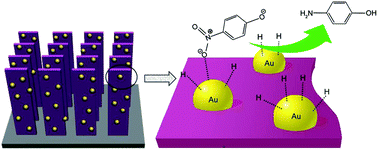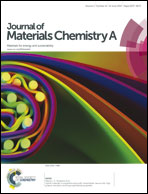A novel structured catalyst: gold supported on thin bimetallic (Ni, Co) carbonate hydroxide nanosheet arrays†
Abstract
Thin bimetallic (Ni, Co) carbonate hydroxide nanosheet arrays (NiCoCH-NSAs) were successfully synthesized by a two-step hydrothermal method, and used as supports of Au nanoparticles to achieve a structured catalyst. The unique architecture of such bimetallic carbonate hydroxide nanosheets with an average thickness of about 50 nm and length of 1.5 μm is beneficial for the deposition of small Au nanoparticles without aggregation. HRTEM results clearly showed that the gold nanoparticles with size of about 2.6 nm ± 0.7 nm were uniformly distributed across the surface of the NiCoCH-NSAs over a large area. As a model reaction, the reduction of 4-nitrophenol (4-NP) by sodium borohydride (NaBH4) was used to evaluate the performance of Au/NiCoCH-NSA catalysts. The obtained results demonstrated that the as-prepared Au/NiCoCH-NSAs exhibited excellent catalytic activity and stability for the reduction of 4-NP. Notably, the catalytic conversion of 4-nitrophenol on a relatively large scale showed the potential of Au/NiCoCH-NSAs as a practical catalyst for industrial applications. In addition, Au/NiCoCH-NSAs could be easily recycled due to the unique architectures of nanoarrays.


 Please wait while we load your content...
Please wait while we load your content...